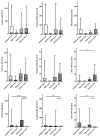Factors Influencing Breast Milk Antibody Titers during the Coronavirus Disease 2019 Pandemic: An Observational Study
- PMID: 39064762
- PMCID: PMC11280407
- DOI: 10.3390/nu16142320
Factors Influencing Breast Milk Antibody Titers during the Coronavirus Disease 2019 Pandemic: An Observational Study
Abstract
The COVID-19 pandemic has highlighted the role of breastfeeding in providing passive immunity to infants via specific anti-SARS-CoV-2 antibodies in breast milk. We aimed to quantify these antibodies across different lactation stages and identify influencing factors. This prospective study involved mother-child dyads from Innsbruck University Hospital, Austria, with a positive maternal SARS-CoV-2 test during pregnancy or peripartum between 2020 and 2023. We collected breast milk samples at various lactation stages and analyzed anti-Spike S1 receptor-binding domain (S1RBD) immunoglobulins (Ig). Maternal and neonatal data were obtained from interviews and medical records. This study included 140 mothers and 144 neonates. Anti-S1RBD-IgA (72.0%), -IgG (86.0%), and -IgM (41.7%) were highly present in colostrum and decreased as milk matured. Mothers with natural infection and vaccination exhibited higher anti-S1RBD-IgA and -IgG titers in all milk stages. Mothers with moderate to severe infections had higher concentrations of anti-S1RBD-IgA and -IgG in transitional milk and higher anti-S1RBD-IgA and -IgM in mature milk compared to those with mild or asymptomatic infections. Variations in antibody responses were also observed with preterm birth and across different virus waves. This study demonstrates the dynamic nature of breast milk Ig and underscores the importance of breastfeeding during a pandemic.
Keywords: COVID-19; SARS-CoV-2; anti-S1RBD immunoglobulins; breast milk; breastfeeding; immunonutrition.
Conflict of interest statement
The authors have no conflicts of interest to declare.
Figures


References
-
- Fernández-Buhigas I., Rayo N., Silos J.C., Serrano B., Ocón-Hernández O., Leung B.W., Delgado J.L., Fernández D.S., Valle S., De Miguel L., et al. Anti-SARS-CoV-2-specific antibodies in human breast milk following SARS-CoV-2 infection during pregnancy: A prospective cohort study. Int. Breastfeed. J. 2024;19:5. doi: 10.1186/s13006-023-00605-w. - DOI - PMC - PubMed
-
- Pace R.M., Williams J.E., Järvinen K.M., Belfort M.B., Pace C.D.W., Lackey K.A., Gogel A.C., Nguyen-Contant P., Kanagaiah P., Fitzgerald T., et al. Characterization of SARS-CoV-2 RNA, Antibodies, and Neutralizing Capacity in Milk Produced by Women with COVID-19. mBio. 2021;12:e03192-20. doi: 10.1128/mBio.03192-20. - DOI - PMC - PubMed
-
- Dimitroglou M., Sokou R., Iacovidou N., Pouliakis A., Kafalidis G., Boutsikou T., Iliodromiti Z. Anti-SARS-CoV-2 Immunoglobulins in Human Milk after Coronavirus Disease or Vaccination-Time Frame and Duration of Detection in Human Milk and Factors That Affect Their Titers: A Systematic Review. Nutrients. 2023;15:1905. doi: 10.3390/nu15081905. - DOI - PMC - PubMed
Publication types
MeSH terms
Substances
Grants and funding
LinkOut - more resources
Full Text Sources
Medical
Miscellaneous

